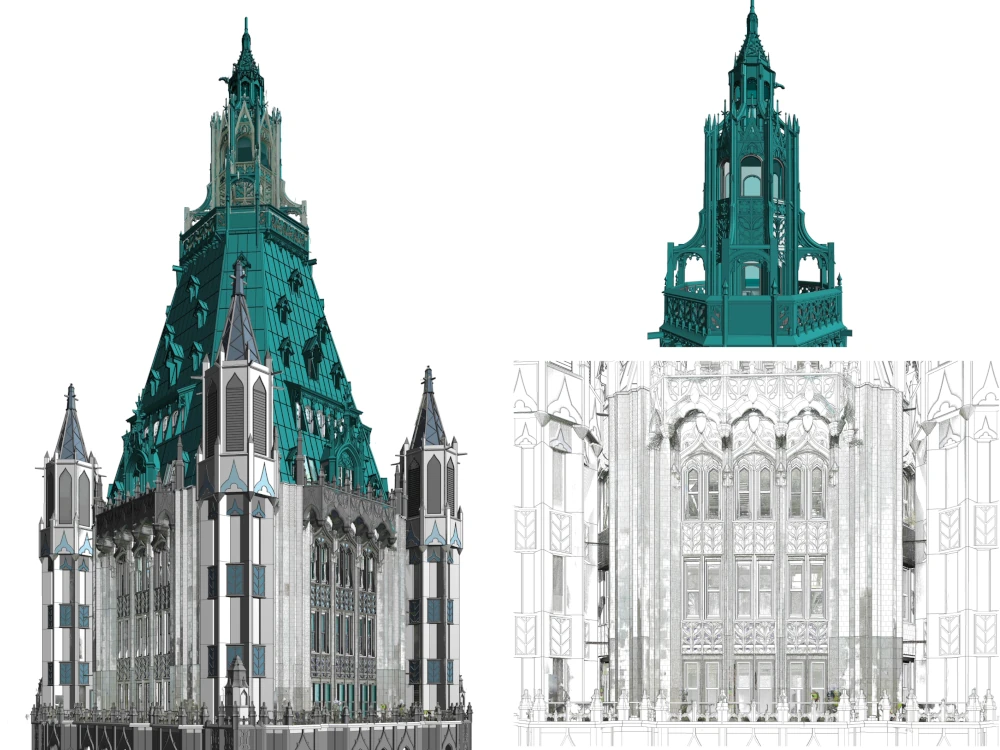Woolworth Building Pinnacle Penthouse
Highlights

Client

Services

Categories

Equipment
The Pinnacle Penthouse is an iconic 5-floor residential space located at the top of the Woolworth Building, a 1913 neo-Gothic skyscraper, once the world's tallest building and a New York architectural landmark. The residence features a distinct copper crown, includes 9,680-square-foot of living space, a private 408 square foot observatory terrace, and panoramic views of New York City.
The Pinnacle Penthouse required a large amount of exterior structural modifications to the façade and envelope conditions. The purchaser desires to restore portions of the exterior to more closely reflect the original Cas Gilbert design.
The interior living space is a blank slate, the architect desires to fully exploit the spatial and experiential opportunities of this unique residence.
The architect required precise documentation of the existing conditions, and a variety of deliverables, including a point cloud, 2D CAD floor plans & RCPs, 3D Revit model, and drone imagery to plan for exterior restoration and design the interior living space.
3D laser scanning and a drone survey will provide highly accurate and detailed documentation of the building’s existing conditions, serving as a crucial foundation for planning exterior restoration efforts. Precise spatial layouts, structural elements, and architectural details will be used to create a state-of-the-art floor plan of the interior living space.
3D Laser Scanning Case Study:
The project architect was tasked with restoring the exterior façade to reflect the original 1913 Cas Gilbert design and finish the interior living space of this unique residence.
The Pinnacle Penthouse required immense exterior structural modifications to the façade and envelope conditions. The residence required modern updates to the mechanical, electrical, and plumbing systems to infuse 21st-century luxuries into the historic space.
3D laser scanning and a drone survey will capture the existing building conditions to plan for exterior restoration and create a state-of-the-art floor plan of the interior living space.
The Architect Requested 3 Phases of Laser Scanning:
August 2023 – Interior Scanning & Demolition:
The initial phase involved interior 3D laser scanning to document existing conditions before demolition and renovation work began. This provided a detailed digital record of the structure, ensuring that modifications to mechanical, electrical, and plumbing (MEP) systems were accurately planned. Interior demolition work followed, allowing for updates and improvements while preserving key architectural elements.
September 2023 – Building Exterior Drone Survey:
A high-resolution drone survey was conducted to capture detailed imagery of the building’s façade and envelope. This provided essential data for evaluating structural integrity and planning exterior modifications. The drone imagery helped identify potential weaknesses, assess material conditions, and support restoration efforts while ensuring that any changes aligned with the building’s historical and architectural significance.
December 2023 – Interior Scanning Completion (Post-Demolition):
Following demolition and initial renovations, a final interior 3D laser scan was performed to document the updated conditions. This allowed architects and engineers to verify changes, assess the success of demolition efforts, and refine plans for further restoration or reconstruction. The updated scans provided a precise digital model to guide the next phases of construction and preservation.

Residence Features:
The Pinnacle Penthouse, recently developed by Alchemy Properties, is an iconic residence in New York. Sitting 727 feet high, this five-story home encompasses 9,680 square feet of interior space and a private 408 square foot observatory terrace. Exquisite highlights include 125 windows, 24-foot ceilings, and an in-residence private elevator.
Built in 1913, the Woolworth Building at 2 Park Place was the world’s tallest building when it was completed. Designed by architect Cass Gilbert for developer Frank Woolworth, construction on the 792-foot-tall neo-Gothic tower cost $13.5 million at the time. Besides its distinct copper crown, the building is known for its striking facade, which is made up of thousands of pieces of terracotta. Alchemy Properties recently restored the terracotta facade for $22 million.
According to Ken Horn, President of Alchemy Properties, “the apartment still needs millions of dollars’ worth of finishing and refurbishing. The home was sold to Scott Lynn, CEO of Masterworks, as an ‘unfinished white box’ -- just steel beams and unfinished interiors painted white -- which Horn says was due to Alchemy Properties knowing that any future owner would come in with ‘their own visions’ for the penthouse.”




Equipment Utilized on Site:
Leica RTC360: Captured 2 million data points per second plus HDR images, delivering a 3D colorized point cloud with 2-6 mm accuracy in under 2 minutes per scan location.
Insta360 X3: Captured high-resolution spherical still exterior images at 72 megapixels that are impressively detailed and captured 5.7K 360° video.
DJI Mini 3: Drone survey captured 4K HDR video with true vertical shooting and intelligent features.
Deliverables:
Point Cloud: The point cloud delivered an accurate dataset of the project site that can be used for visualization, analysis, design, construction, and renovation planning.
2D CAD Floor Plans: Floor plans disclosed the layout and spatial relationship between rooms, spaces, and elements such as walls, doors, windows, and furniture.
RCPs: A reflected ceiling plan documented the outline of the ceilings, the varied ceiling levels, vent locations, and the different types of lighting fixtures.
TruViews: TruView will let the architect navigate the point cloud, measure, markup, and visualize the design model against real-world conditions.
3D Revit Model: A 3D Revit model helped to detect design conflicts early. It streamlined coordination between disciplines like architecture, engineering, and plumbing, while also helping to generate detailed schedules and cost estimates. This can lead to fewer errors, better project management, and cost savings.
Drone Survey: Drones provided instant site images and video, delivering accurate existing building conditions for the architect to make decisions. Drones are a safe, cost-effective tool for remote inspections and project monitoring.
Virtual Tour: A virtual tour allowed the architect to walk around and explore the Penthouse without visiting it in person.
The architect is able to securely access, view, download, and share all as-built site data, drawings, and models via SiteMap®, a cloud-based software to facilitate collaboration, communication, and ultimately, better decision making.
Accurate, real-time as-built data is essential for informed decision-making and seamless collaboration. With precise design plans from the start, the Architect developing the Pinnacle Penthouse can streamline fieldwork and minimize change orders, plus avoid delays and extra costs.
.webp)
Existing Conditions 3D Laser Scanning Services
Over the past 27 years, Existing Conditions has measured, documented, and modeled over 10,000 buildings across the United States, establishing ourselves as an industry leader in 3D laser scanning.
Architects trust us to deliver digital representations of the as-built environment with unparalleled accuracy and efficiency. Our dedicated Project Managers provide fast and accurate 3D laser scanning services and drone imagery services, and expert CAD and BIM technicians create custom, detailed deliverables, including point clouds, 2D CAD drawings, 3D BIM models, 3D mesh models, TruViews, and 3D virtual tours.
Our greatest reward remains delivering superior-quality scan-to-BIM work and knowing we played a vital role in our clients’ historical architecture and preservation projects.
Related Case Studies



















